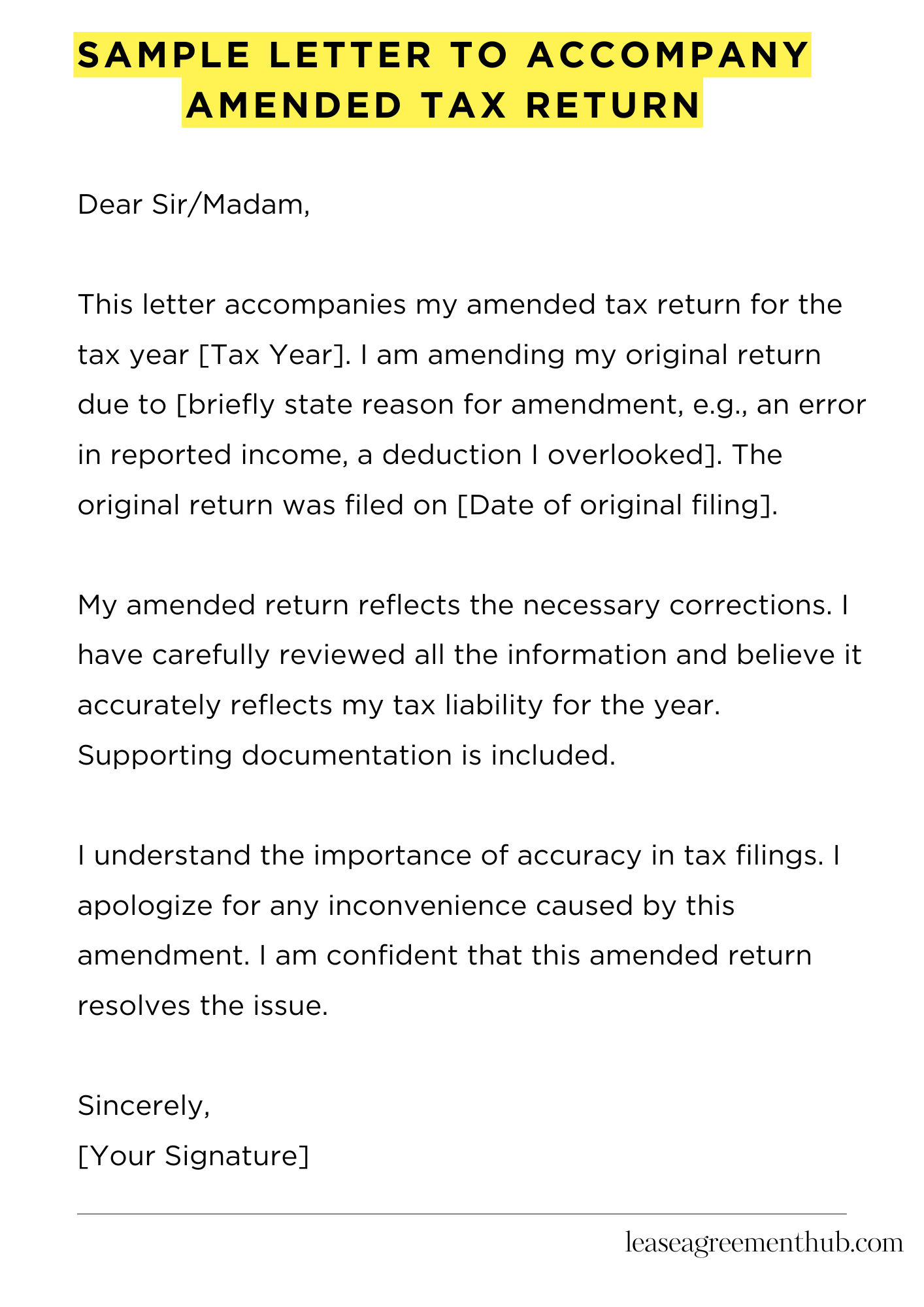An amended tax return fixes mistakes on your original return. A cover letter explains the changes. It’s crucial for a smooth process.
This article gives you example letters. These are templates. They’ll help you write your own letter. Use them as a guide.
We provide various samples. They cover different situations. You’ll find the perfect fit for your needs.
Sample Letter to Accompany Amended Tax Return
[Your Name]
[Your Address]
[Your Phone Number]
[Your Email Address]
[Date]
Internal Revenue Service
[IRS Address]
Subject: Amended Tax Return – [Your Social Security Number] – Tax Year [Tax Year]
Dear Sir/Madam,
This letter accompanies my amended tax return for the tax year [Tax Year]. I am amending my original return due to [briefly state reason for amendment, e.g., an error in reported income, a deduction I overlooked]. The original return was filed on [Date of original filing].
My amended return reflects the necessary corrections. I have carefully reviewed all the information and believe it accurately reflects my tax liability for the year. Supporting documentation is included. Specifically, please see [mention specific documents included, e.g., Form W-2C showing corrected wages, bank statement showing corrected interest income].
I understand the importance of accuracy in tax filings. I apologize for any inconvenience caused by this amendment. I am confident that this amended return resolves the issue.
Please contact me if you require any further information. My contact details are listed above.
Sincerely,
[Your Signature]

How to Write a Sample Letter to Accompany Amended Tax Return
Understanding the Necessity of an Accompanying Letter
Filing an amended tax return, denoted as Form 1040-X, isn’t just about correcting numerical errors; it’s a formal process demanding meticulous attention to detail. A well-crafted accompanying letter is crucial. It contextualizes your amendments, providing the IRS with a clear, concise narrative of the changes and their justifications. This letter isn’t optional; it’s the linchpin for a successful amendment.
Structuring Your Letter for Optimal Clarity
Begin with a professional salutation, addressing the relevant IRS department. Directly state your intention: to amend your previous return. Provide pertinent identifying information—your name, address, social security number, and the tax year in question. Use numbered points to delineate each correction, avoiding obfuscation. Each point should clearly state the error, its rectification, and supporting documentation (if applicable). Conclude with a polite closing and your signature.
Crafting Compelling Arguments: Justifying Your Amendments
Mere assertions won’t suffice. Each correction needs a robust rationale. This might involve citing specific supporting documents, like W-2 revisions or overlooked deductions. Legitimate discrepancies should be explicitly detailed, employing precise language to prevent ambiguity. Remember, your goal is to persuade the IRS of the validity of your amendments, not to merely inform them.
Employing Precise Language and Avoiding Jargon
While incorporating sophisticated vocabulary can enhance your letter’s potency, avoid overly technical or arcane terms. Precision is paramount, but clarity trumps complexity. Use clear, unambiguous language, favoring active voice constructions for a more persuasive and confident tone.
The Importance of Supporting Documentation
Your letter is the narrative; supporting documents are the evidence. Attach copies of any relevant documentation that substantiates your claims. This might include corrected pay stubs, receipts, or bank statements. Organize these meticulously, referencing them specifically within your letter to create a cohesive and easily auditable package. Failure to provide sufficient documentation weakens your argument considerably.
Reviewing and Proofreading for Impeccable Presentation
Before submitting your letter, conduct a rigorous review. Carefully check for grammatical errors, typographical mistakes, and inconsistencies. A poorly presented document undermines your credibility and increases the likelihood of delays or rejection. Consider having a second pair of eyes examine your work before submission.
Ensuring Timely Submission and Maintaining Records
Submit your amended return and accompanying letter within the prescribed timeframe. Keep copies of everything—the amended return, your letter, and all supporting documentation—for your records. This proactive approach safeguards you against potential future disputes. Consider using certified mail with return receipt requested for irrefutable proof of submission.
FAQs about sample letter to accompany amended tax return
What information should be included in a letter accompanying an amended tax return?
The letter should clearly state the reason for the amendment, referencing the specific tax form and line number(s) being corrected. Include supporting documentation details and your contact information. Be concise and factual.
How formal should the tone of the letter be?
Maintain a professional and respectful tone. Avoid informal language or emotional expressions. A clear and concise style is best.
What if I made multiple errors on my original return?
Address each error separately and clearly in the letter. Organize the information logically and use bullet points if necessary to improve readability.
Where should I send the amended return and letter?
The amended return and letter should be sent to the appropriate address for your tax jurisdiction. This is typically found on the instructions for the amended tax form (Form 1040-X).
What if I don’t have all the necessary supporting documentation?
Explain the situation in your letter, stating what documentation you do have and what you are still trying to obtain. You may want to request an extension if necessary, following IRS guidelines.
Related: